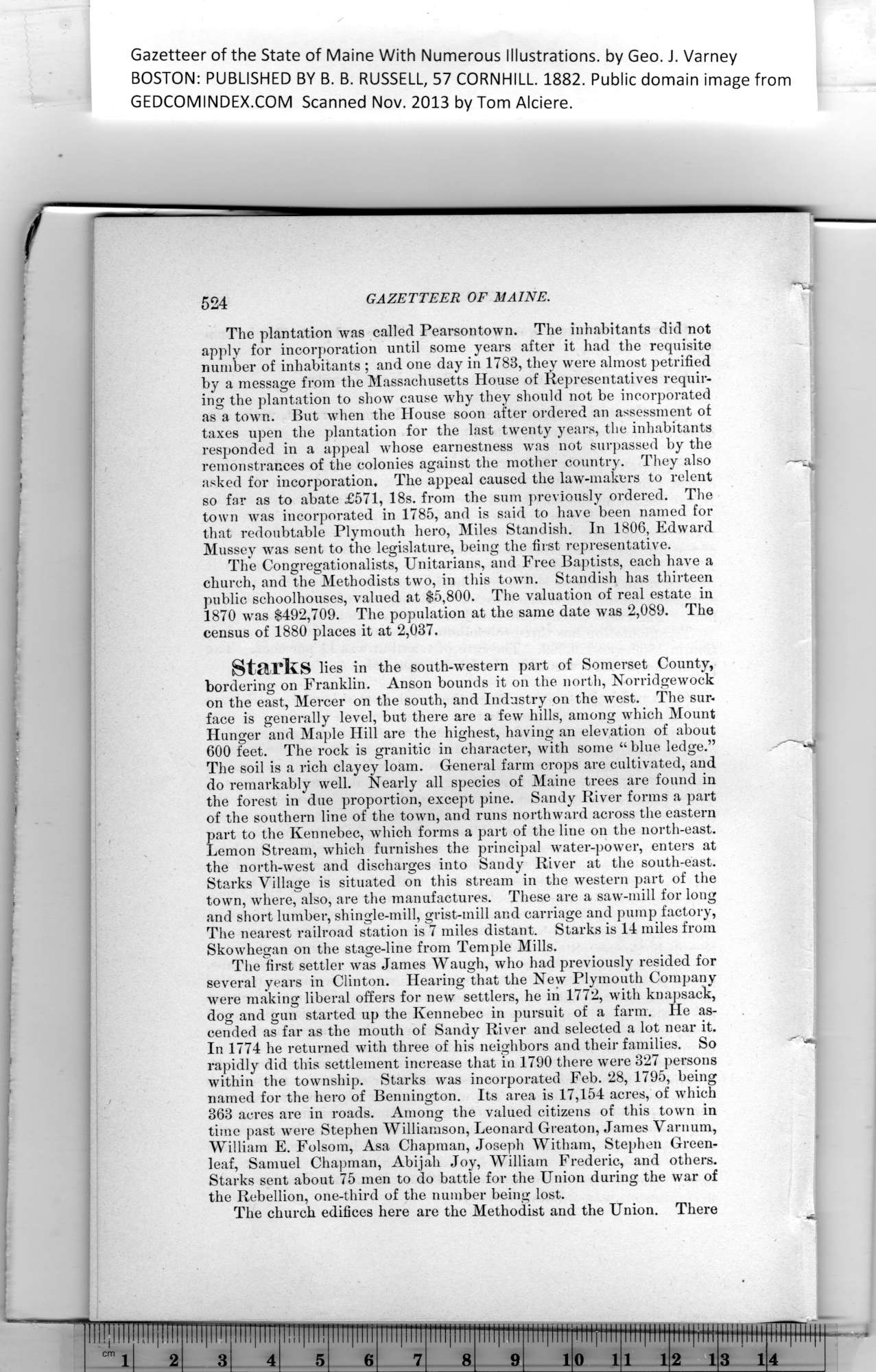|
Gazetteer of the State of Maine With Numerous Illustrations, by Geo. J. Varney
BOSTON: PUBLISHED BY B. B. RUSSELL, 57 CORNHILL. 1882. Public domain image from
3E
524 GAZETTEER OF MAINE. ~
The plantation was called Pearsontown. The inhabitants did not
apply for incorporation until some years after it had the requisite
number of inhabitants ; and one day in 1783, they were almost petrified
by a message from the Massachusetts House of Representatives requir-
ing the plantation to show cause why they should not be incorporated
as a town. But when the House soon after ordered an assessment of
taxes upen the plantation for the last twenty years, the inhabitants
responded in a appeal whose earnestness was not surpassed by the
remonstrances of the colonies against the mother country. They also —^
asked for incorporation. The appeal caused the law-makers to relent
so far as to abate £571, 18s. from the sum previously ordered. The
town was incorporated in 1785, and is said to have been named for
that redoubtable Plymouth hero, Miles Standish. In 1806, Edward
Mussey was sent to the legislature, being the first representative.
The Congregationalists, Unitarians, and Free Baptists, each have a
church, and the Methodists two, in this town. Standish has thirteen
public schoolhouses, valued at $5,800. The valuation of real estate in
1870 was $492,709. The population at the same date was 2,089. The
census of 1880 places it at 2,037.
StclTfcS lies in the south-western part of Somerset County,
bordering on Franklin. Anson bounds it on the north, Norridgewock
on the east, Mercer on the south, and Industry on the west. The sur-
face is generally level, but there are a few hills, among which Mount
Hunger and Maple Hill are the highest, having an elevation of about
600 feet. The rock is granitic in character, with some “ blue ledge.”
The soil is a rich clayey loam. General farm crops are cultivated, and
do remarkably well. Nearly all species of Maine trees are found in
the forest in due proportion, except pine. Sandy River forms a part
of the southern line of the town, and runs northward across the eastern
part to the Kennebec, which forms a part of the line on the north-east.
Lemon Stream, which furnishes the principal water-power, enters at
the north-west and discharges into Sandy River at the south-east.
Starks Village is situated on this stream in the western part of the
town, where, also, are the manufactures. These are a saw-mill for long
and short lumber, shingle-mill, grist-mill and carriage and pump factory,
The nearest railroad station is 7 miles distant. Starks is 14 miles from
Skowhegan on the stage-line from Temple Mills.
The first settler was James Waugh, who had previously resided for
several years in Clinton. Hearing that the New Plymouth Company
were making liberal offers for new settlers, he in 1772, with knapsack,
dog and gun started up the Kennebec in pursuit of a farm. He as-
cended as far as the mouth of Sandy River and selected a lot near it.
In 1774 he returned with three of his neighbors and their families. So
rapidly did this settlement increase that in 1790 there were 327 persons
within the township. Starks was incorporated Feb. 28, 1795, being
named for the hero of Bennington. Its area is 17,154 acres, of which
363 acres are in roads. Among the valued citizens of this town in
time past were Stephen Williamson, Leonard Greaton, James Varnum,
William E. Folsom, Asa Chapman, Joseph Witham, Stephen Green-
leaf, Samuel Chapman, Abijah Joy, William Frederic, and others.
Starks sent about 75 men to do battle for the Union during the war of
the Rebellion, one-third of the number being lost.
The church edifices here are the Methodist and the Union. There I
PREVIOUS PAGE ... NEXT PAGE
This page was written in HTML using a program written in Python 3.2
| 